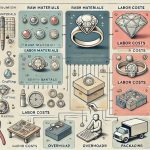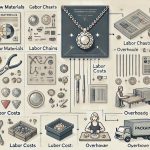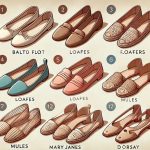Televisions are a cornerstone of modern entertainment, offering a range of features from basic viewing to smart connectivity and high-definition display technologies. The production of televisions involves several key components and processes, each contributing to the overall cost.
How Televisions are Produced
Television production is a complex and intricate process that involves multiple stages, from the initial design and component manufacturing to the final assembly and quality control. Understanding how televisions are produced sheds light on the sophisticated technology and engineering that goes into creating a device that is now a staple in households worldwide.
Design and Conceptualization
The production of a television begins with the design and conceptualization phase. This stage involves a team of engineers, designers, and product developers who collaborate to create a new television model. They focus on various aspects such as screen size, resolution, form factor, and additional features like smart capabilities and connectivity options.
The design team uses advanced software tools to create detailed blueprints and 3D models of the television. These models allow them to simulate the device’s performance, durability, and aesthetic appeal. Once the design is finalized, it moves on to the prototyping stage, where a working model of the television is created. This prototype is tested extensively to ensure that it meets all the required specifications and standards.
Component Manufacturing
After the design is approved, the next step is the manufacturing of the components that will make up the television. This includes the display panel, circuit boards, speakers, and casing, among other parts. Each of these components is produced in specialized manufacturing plants.
The display panel, one of the most critical parts of the television, is typically produced using either LED (Light Emitting Diode) or OLED (Organic Light Emitting Diode) technology. The production of these panels involves several complex processes, including the deposition of thin layers of materials onto a substrate, followed by the precise alignment of these layers to create the pixels that make up the screen.
Circuit boards, which house the television’s electronic components, are produced using a process called PCB (Printed Circuit Board) manufacturing. This involves etching conductive pathways onto a non-conductive substrate, then soldering components like microprocessors, resistors, and capacitors onto the board. These circuit boards are responsible for controlling various functions of the television, such as image processing, sound output, and connectivity.
Assembly of Components
Once all the components are manufactured, they are shipped to an assembly plant, where the actual television is put together. The assembly process begins with the mounting of the display panel onto the television’s frame. This is followed by the installation of the circuit boards, speakers, and other internal components.
The assembly process is highly automated, with robotic arms and conveyor belts being used to move and position components. However, certain tasks, such as wiring and connecting cables, may still be done manually to ensure precision.
During assembly, each television undergoes multiple quality checks to ensure that all components are correctly installed and functioning as expected. These checks include visual inspections, functional tests, and automated tests that verify the television’s performance.
Software Installation and Calibration
After the hardware assembly is complete, the television moves on to the software installation phase. Modern televisions, especially smart TVs, require operating systems and firmware to be installed. This software controls everything from the user interface to the connectivity options and ensures that the television can perform all its intended functions.
Once the software is installed, the television is calibrated to ensure optimal performance. Calibration involves adjusting various settings such as brightness, contrast, color balance, and sound quality to match the manufacturer’s specifications. This step is crucial to delivering the best possible viewing experience to the end user.
Quality Control and Testing
The final step in the television production process is quality control and testing. Each television is subjected to a series of rigorous tests to ensure that it meets the highest standards of quality and reliability. These tests include:
- Visual Inspection: A thorough examination of the television’s exterior to check for any physical defects, such as scratches, dents, or misaligned components.
- Functional Testing: The television is powered on, and all its features are tested to ensure they are working correctly. This includes checking the display, sound, remote control functionality, and connectivity options like HDMI and Wi-Fi.
- Environmental Testing: The television is subjected to extreme conditions, such as high temperatures, humidity, and electrical surges, to ensure that it can withstand real-world usage.
- Aging Test: The television is left on for an extended period to simulate long-term use and check for any potential issues that might arise over time.
Only after passing all these tests is the television approved for packaging and distribution.
Packaging and Distribution
Once a television has passed all quality checks, it is ready for packaging. The packaging process involves placing the television in a protective box, along with necessary accessories like remote control, user manual, and power cables. The packaging is designed to protect the television during shipping and handling.
After packaging, the televisions are stored in a warehouse before being distributed to retailers and customers. The distribution process involves coordinating with logistics companies to ensure that the televisions are delivered on time and in perfect condition.
Production Cost Distribution
The production cost of televisions typically includes:
- Components (40-50%): This includes the display panel, backlight, processor, memory, and other hardware components.
- Assembly and Manufacturing (20-25%): Costs related to assembling the components, quality control, and manufacturing overheads.
- Research and Development (10-15%): Investments in design, technology development, and software.
- Marketing and Distribution (5-10%): Costs associated with marketing campaigns, packaging, and distribution logistics.
- Other Costs (5-10%): Includes administrative expenses, taxes, and miscellaneous costs.
Types of Televisions

1. LED Televisions
Overview
LED televisions are the most common type of TV, known for their energy efficiency and slim design. They use light-emitting diodes (LEDs) as a backlight for the LCD panel, providing bright and vibrant pictures with lower power consumption compared to older technologies.
Popular Brands
| Brand | Established | Location |
|---|---|---|
| Samsung | 1938 | Seoul, South Korea |
| LG | 1947 | Seoul, South Korea |
| Sony | 1946 | Tokyo, Japan |
| Vizio | 2002 | Irvine, USA |
| TCL | 1981 | Huizhou, China |
Averaged Retail Price on Amazon
- $200 – $700
Market Popularity
LED TVs are highly popular due to their affordability, wide range of sizes, and good picture quality. They are widely used in homes, offices, and public places.
Production Details
- White Label Production Cost in China: $100 – $300 per unit
- Product Weight: 5 – 15 kg
- Minimum Order Quantity: 1,000 units
- Major Materials: LCD panel, LED backlight, plastic housing
2. OLED Televisions
Overview
OLED televisions offer superior picture quality with deep blacks, vibrant colors, and wide viewing angles. They use organic light-emitting diodes that emit light individually, eliminating the need for a backlight and allowing for thinner, more flexible displays.
Popular Brands
| Brand | Established | Location |
|---|---|---|
| LG | 1947 | Seoul, South Korea |
| Sony | 1946 | Tokyo, Japan |
| Panasonic | 1918 | Osaka, Japan |
| Philips | 1891 | Amsterdam, Netherlands |
| Vizio | 2002 | Irvine, USA |
Averaged Retail Price on Amazon
- $1,200 – $3,000
Market Popularity
OLED TVs are popular among enthusiasts and those seeking the best picture quality. Their ability to display true blacks and rich colors makes them highly desirable for home theaters.
Production Details
- White Label Production Cost in China: $500 – $1,200 per unit
- Product Weight: 10 – 25 kg
- Minimum Order Quantity: 500 units
- Major Materials: OLED panel, glass, aluminum frame
3. QLED Televisions
Overview
QLED televisions use quantum dot technology to enhance color and brightness. These TVs have LED backlighting but incorporate a layer of quantum dots to produce more vibrant and accurate colors compared to standard LED TVs.
Popular Brands
| Brand | Established | Location |
|---|---|---|
| Samsung | 1938 | Seoul, South Korea |
| TCL | 1981 | Huizhou, China |
| Vizio | 2002 | Irvine, USA |
| Hisense | 1969 | Qingdao, China |
| LG | 1947 | Seoul, South Korea |
Averaged Retail Price on Amazon
- $800 – $2,000
Market Popularity
QLED TVs are popular for their enhanced picture quality and brightness. They are a favorite among consumers looking for high-performance displays for both bright and dark rooms.
Production Details
- White Label Production Cost in China: $400 – $900 per unit
- Product Weight: 10 – 20 kg
- Minimum Order Quantity: 1,000 units
- Major Materials: Quantum dot layer, LED backlight, LCD panel, plastic housing
4. 4K Ultra HD Televisions
Overview
4K Ultra HD televisions offer a resolution of 3840 x 2160 pixels, providing four times the detail of Full HD. This higher resolution results in sharper images and more detailed visuals, making 4K TVs ideal for large screens.
Popular Brands
| Brand | Established | Location |
|---|---|---|
| Samsung | 1938 | Seoul, South Korea |
| Sony | 1946 | Tokyo, Japan |
| LG | 1947 | Seoul, South Korea |
| Vizio | 2002 | Irvine, USA |
| Hisense | 1969 | Qingdao, China |
Averaged Retail Price on Amazon
- $300 – $1,500
Market Popularity
4K TVs are increasingly popular as more 4K content becomes available. They are favored for their superior image clarity and are becoming standard in new TV purchases.
Production Details
- White Label Production Cost in China: $200 – $600 per unit
- Product Weight: 7 – 20 kg
- Minimum Order Quantity: 1,000 units
- Major Materials: 4K LCD panel, LED backlight, plastic housing
5. 8K Ultra HD Televisions
Overview
8K Ultra HD televisions provide a resolution of 7680 x 4320 pixels, offering unmatched detail and clarity. They are designed for the most demanding viewers who want the highest possible picture quality.
Popular Brands
| Brand | Established | Location |
|---|---|---|
| Samsung | 1938 | Seoul, South Korea |
| LG | 1947 | Seoul, South Korea |
| Sony | 1946 | Tokyo, Japan |
| TCL | 1981 | Huizhou, China |
| Sharp | 1912 | Sakai, Japan |
Averaged Retail Price on Amazon
- $3,000 – $10,000
Market Popularity
8K TVs are currently a niche market due to their high cost and limited 8K content. However, they are gaining traction among early adopters and technology enthusiasts.
Production Details
- White Label Production Cost in China: $1,500 – $4,000 per unit
- Product Weight: 15 – 30 kg
- Minimum Order Quantity: 500 units
- Major Materials: 8K LCD panel, LED backlight, aluminum/plastic housing
6. Smart Televisions
Overview
Smart televisions come with built-in internet connectivity and a range of apps, allowing users to stream content, browse the web, and access social media directly from their TV.
Popular Brands
| Brand | Established | Location |
|---|---|---|
| Samsung | 1938 | Seoul, South Korea |
| LG | 1947 | Seoul, South Korea |
| Sony | 1946 | Tokyo, Japan |
| Vizio | 2002 | Irvine, USA |
| TCL | 1981 | Huizhou, China |
Averaged Retail Price on Amazon
- $300 – $1,000
Market Popularity
Smart TVs are very popular due to their convenience and versatility. They appeal to a wide range of consumers looking to integrate their TV with online services and smart home devices.
Production Details
- White Label Production Cost in China: $150 – $400 per unit
- Product Weight: 6 – 15 kg
- Minimum Order Quantity: 1,000 units
- Major Materials: LCD panel, LED backlight, Wi-Fi module, plastic housing
7. Curved Televisions
Overview
Curved televisions are designed to provide an immersive viewing experience with a slight curve that wraps around the viewer’s field of vision. This design aims to enhance depth perception and reduce glare.
Popular Brands
| Brand | Established | Location |
|---|---|---|
| Samsung | 1938 | Seoul, South Korea |
| LG | 1947 | Seoul, South Korea |
| Sony | 1946 | Tokyo, Japan |
| TCL | 1981 | Huizhou, China |
| Hisense | 1969 | Qingdao, China |
Averaged Retail Price on Amazon
- $500 – $2,000
Market Popularity
Curved TVs are popular among home theater enthusiasts and those seeking an enhanced visual experience. They are, however, less common than flat-screen models.
Production Details
- White Label Production Cost in China: $300 – $700 per unit
- Product Weight: 10 – 20 kg
- Minimum Order Quantity: 500 units
- Major Materials: Curved LCD panel, LED backlight, plastic/metal housing
8. HDR Televisions
Overview
HDR (High Dynamic Range) televisions offer improved contrast, color accuracy, and brightness compared to standard TVs. They enhance the viewing experience by making images more lifelike and detailed.
Popular Brands
| Brand | Established | Location |
|---|---|---|
| Samsung | 1938 | Seoul, South Korea |
| Sony | 1946 | Tokyo, Japan |
| LG | 1947 | Seoul, South Korea |
| TCL | 1981 | Huizhou, China |
| Hisense | 1969 | Qingdao, China |
Averaged Retail Price on Amazon
- $400 – $1,500
Market Popularity
HDR TVs are becoming increasingly popular as more content becomes available in HDR format. They are favored by consumers who prioritize picture quality and visual experience.
Production Details
- White Label Production Cost in China: $200 – $500 per unit
- Product Weight: 8 – 18 kg
- Minimum Order Quantity: 1,000 units
- Major Materials: HDR LCD panel, LED backlight, plastic housing
9. Outdoor Televisions
Overview
Outdoor televisions are designed to withstand various weather conditions, including rain, dust, and extreme temperatures. They are typically used in outdoor entertainment areas such as patios, poolside, and gardens.
Popular Brands
| Brand | Established | Location |
|---|---|---|
| SunBriteTV | 2004 | Thousand Oaks, USA |
| Séura | 2004 | Green Bay, USA |
| SkyVue | 2010 | Charlotte, USA |
| MirageVision | 2013 | Las Vegas, USA |
| LG | 1947 | Seoul, South Korea |
Averaged Retail Price on Amazon
- $1,500 – $5,000
Market Popularity
Outdoor TVs are popular among homeowners and businesses looking to enhance their outdoor entertainment spaces. They are specifically designed for durability and performance in outdoor environments.
Production Details
- White Label Production Cost in China: $700 – $2,000 per unit
- Product Weight: 20 – 35 kg
- Minimum Order Quantity: 200 units
- Major Materials: Weatherproof casing, outdoor-rated LCD panel, LED backlight








